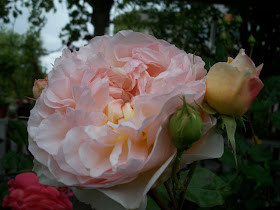Received in the mail: Plant materials of various cactus orchid varieties.
I was on Facebook one day and I saw Evelyn, one of my relatives who live in Southern California, posted pictures of gorgeous flowers from her cactus orchid collection. Jokingly, I asked her if she could please send me some plant materials. She said no problem. A couple of days later I got a Priority package in the mail. I was ecstatic but I have no idea on how to grow them. Evelyn said they are very easy to grow. The plants don't like direct sunlight. Good drainage is important as they tend to rot with too much soil moisture.

After a couple of days: Soil media and pot now hold the plant materials.
Temporarily they are sitting in one corner of the back patio hiding from the sun behind a huge Ficus benjamina in an oak barrel. The one-gallon pots seem very small for the lengths of the leaves that I planted. As soon as they get established I will transfer them to bigger pots. Labeling these plants seem to be convenient...just write on the leaves.
So here I am feeling as if I adapted children without any experience in raising kids at all.
Wish me success or give me some advice.


























